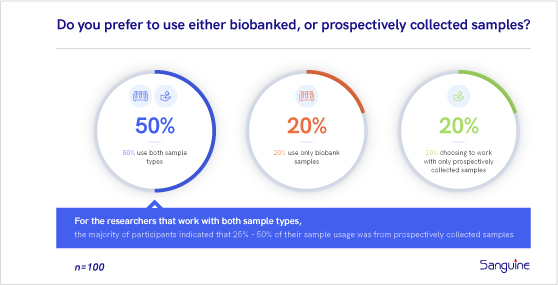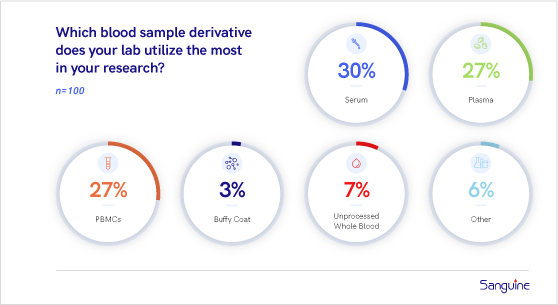Trends in Biospecimen Collection
The use of biospecimens in clinical research is integral to driving scientific discoveries and answering important biological questions. Acquiring biospecimens for a research study typically follows one of two models: (1) using samples collected retrospectively and stored in biobanks or (2) prospectively collected samples that are collected fresh on-demand from a target population. Approximately half of the researchers we surveyed indicated that they utilize both retrospectively and prospectively collected samples in their research. Many important considerations when deciding whether to use retrospective or prospective samples collection are highlighted below.
Retrospective Collection
A biobank collects biospecimens on the expectation of a future researcher’s requests. They contain samples that have been retrospectively collected and stored long-term, following consent by the donor to allow for future research use. They are often large, broad-focused centers that collect common biospecimens that could be widely used by many researchers across various fields.
Benefits of Retrospective Collection
Getting access to a large collection of biospecimens can often be faster to achieve when all the samples have been retrospectively stored in a biobank and can quickly be ordered based on certain criteria. Biobanks can also provide post-mortem biospecimens, particularly of tissues that would otherwise be impossible to collect prospectively, such as neurological samples. This form of collection is also advantageous in that it can store valuable tissues post-surgical removal, such as certain tumor types, making a large collection of difficult to obtain samples easily available for researchers. However, if a researcher requires particular molecular characteristics in the sample and this is not typically characterized as part of standard clinical care, it may be difficult to obtain this specific information after the sample has already been stored, often for years. Overall, retrospectively collected samples can be a suitable route when the selection of biospecimens does not require specific criteria, conditions or patient populations to fit their study needs.
Prospective Collection
Prospective sample collection is a model that allows for biospecimens to be collected based on real-time requests from the researcher, rather than indefinite collection and storage of a large number of samples. This approach has a smaller footprint as less infrastructure is required, making it more sustainable and affordable than would be expected.
Benefits of Prospective Collection
Prospectively collected samples can be considered a more ethical approach to research. The consenting donor is aware of exactly how their samples will be used prior to donation and it avoids the chance of subjecting a donor to unnecessary sample collection if their sample remains unused in a biobank.
Prospective sample collection allows for longitudinal or event-based sampling that can be tailored based on specific disease triggers or events outlined in the study protocol. Researchers can also be more selective with their inclusion/exclusion criteria and can have more confidence that the samples collected meet their exact needs for their studies. Often with retrospectively collected samples, critical information may be missing within the sample metadata and getting access to this is usually impossible given that samples are deidentified and sample donors are often no longer reachable.
Through prospective sampling, a researcher can have greater confidence that the samples are being collected in the same manner for the whole study and that there are no differences in sample handling that could impact the results of the study. It also allows a researcher to develop complex collection protocols that may consist of multiple processing or preservation methods. Often when relying on banked samples and especially if utilizing more than one repository for the same study, there may be sample processing differences that could impact downstream analyses, such as testing of sensitive biomarkers. Additionally, sometimes artifacts (for example, molecular changes or modified proteomic signatures) can be introduced through freezing and storage, so fresh biospecimen collection may be preferred for some applications. Overall, prospective sample collection allows for greater flexibility for the researcher to provide exact collection, processing or storage instructions for specialized downstream analyses, which can increase the quality of the data generated.
Based on our survey, the most common sample type collected prospectively are serum samples. Sanguine can isolate fresh serum within an hour of collection and can even have it delivered to your lab on the same day from certain geographic areas. We also provide a large variety of blood-derived and non-blood-derived samples and tissues based on the study needs. This can be supplemented with other customized data, such as patient-reported outcomes or wearable technologies.
Sanguine stands out because of our extensive patient database that gives researchers access to >70,000 patients across the United States. Using our mobile team, we can collect on-demand samples, with rapid turnaround times directly in the participant’s home, reducing barriers to research participation. With such an extensive database, we can often meet the most stringent inclusion and exclusion criteria as well as providing access to rare disease populations across the United States. Longitudinal and event-based sampling is done with ease due to our >90% study retention rate and continuous focus on patient engagement. Working with Sanguine means having access to the highest quality prospectively collected samples from the ideal patient population to maximize the chances of generating meaningful conclusions to research questions.
Overall, although both sample procurement models have their benefits, prospective sample collection can provide researchers with the greatest flexibility and often higher quality samples and data to propel your study towards success.


